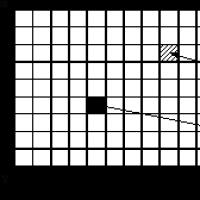IPv6 - what is it? How do I enable iPv6? How to find your own IP address
MTS has become affordable opportunity connect to IPv6. This could have been done previously only within the city of Moscow. Today, the regions of Moscow can also connect to the service, and most importantly - completely free of charge. Thanks to it, subscribers can use Internet services in two addresses - IPv4 and IPv6. Read more about access to IPv6 in MTS and what kind of service it is, read on.
MTS Access to IPv6 service logo
IPv6 is a new Internet protocol that solves the problem of the previous IPv4 version. The fact is that the addresses of the previous protocol ended, since it used an address length of only 32 bits. The version is able to connect a limited number of users to the network - only about 4.3 billion. As of 2016, most organizations around the world announced a shortage of unique addresses. A new version IPv6 uses a 128-bit address length and completely eliminates the shortage problem.
At the same time, its use also gives hidden opportunities to the user. Such as access to blocked resources (if they support it), it works on all devices without exception. But there are also limitations. The service is not available on tariffs where it is disabled Mobile Internet, as well as on fixed-line tariffs. The user's mobile device itself must support it.
The purpose of connecting IPv6 MTS
Many people ask themselves why they need access to IPv6 MTS and what kind of service it is? With the help of the new Internet protocol, subscribers can use two IP addresses at once - IPv6 and IPv4. Thus, they have the opportunity to go to the resources on which they were blocked (i.e. their IP address). You just need to go to another address - and the resource is available again. With the help of the service, you can get access to dangerous sites that cannot be reached with IPv4.
The MTS IPv6 access service increases security when connecting to the Internet by filtering ports that are potentially dangerous. But one cannot rely only on the capabilities of this service, the operator recommends using additional protection methods, such as Antiviruses and firewalls.
Setting up and connecting the service
Before connecting IPv6 to MTS, make sure that your device supports it. Initially, you need to configure the access point of your device. To do this, specify internet.mts.ru in the settings and set the APN protocol - IPv4 / IPv6. Most modern devices already have these settings by default. If you need a specific protocol, then set the one you need here in the settings by selecting one of the proposed options.

You must understand that by choosing IPv4, you will only be using it. IPv6 will not be available.

It can be used to connect access to IPv6 in the MTS USSD request.
- To do this, type the following combination on the keyboard of your smartphone: * 111 * 1428 * 1 #.
- To deactivate the service, use another combination: * 111 * 1428 * 2 #.
- After sending the command, you will be notified by a message about the current status of the service.
There is another way to connect - via SMS. To activate IPv6 service send message with text 1 to short number 1428. To disconnect, you need to send the number 2 in the text of the message to the same number.
When the service in MTS is activated, you may need to reboot your device to activate Dual-Stack IPv4 / IPv6 mode. In this case, the network will be rebooted. When connected, funds should not be withdrawn from your account. Everyone knows that this service of access to IPv6 MTS is free of charge.
How to check a valid IP
After connecting the IPv6 MTS service, there is no way to check the current IP address by built-in means. But you can be helped by special services that determine your current address, DNS server, Internet provider and other information. For all devices and Windows versions and Android, the following 2 sites are suitable: test-ipv6.com, ipv6-test.com. When visiting resources, there is no need to open sections or press buttons. Information is displayed on them automatically. A table will appear in front of the user, where you can get acquainted with the details.
For Apple devices there is a separate resource that displays the current IP. Here when you visit you will also receive detailed information according to your connection. It is necessary to visit these sites after the MTS "Access to IPv6" service has already been activated.
In contact with
Received in due time the name of the Internet, special access protocols are used. One of the newest is IPv6. Not everyone knows what it is and how it all works. Therefore, it is worthwhile to dwell separately on the technology used and on activating the protocol settings, taking into account the fact that the material will be presented in the simplest possible terms, aimed not at professionals, but at ordinary users.
IPv6: what is it?
Despite the fact that today there are quite a few protocols for using the Internet connection in the form of the most commonly used IPv4 or access to mail servers like POP3 or SMTP, we will focus on the sixth version of IP.
Actually, the procedure for accessing the World Wide Web is to identify each connected computer. Moreover, any computer or mobile device must have its own completely unique identifier, called an address. In other words, the essence of using any protocol is that there are no duplicate values in the world.
Why is this needed? Yes, only so that the response of the requested server or the download of data is made to the specified device, and not to another system. The IPv6 protocol itself is responsible for generating and assigning such identifiers. Roughly speaking, when you use it, a unique combination is created that corresponds to each device. At the same time, it is he who generates an almost unlimited number of such identifiers, which, given the development of mobile technology, is becoming especially relevant these days.
History of creation and implementation of IP protocols
Information sources claim that the development of such techniques began in the 70s of the last century. Then one of the technologies was called the Internet Protocol, or, in the English version, Internet Protocol, from where, in fact, the abbreviation comes from.

The fourth version, once the most relevant, was considered the height of perfection, since it could generate 32-bit addresses allocated via DHCP servers in the amount of about four billion identifiers. With a population of our planet of five billion and enough limited circle users of the World Wide Web, this was considered the height of perfection. But at the end of the 20th and at the beginning of the 21st century, with the increase in the number of computers and mobile devices, the fourth version of the protocol no longer coped with the tasks assigned to it. That is why the idea of creating a new IPv6 protocol arose. What it is?

The technology was based on increasing the bitness of the assigned address, but it was preceded by the appearance of an intermediate fifth modification, which received the abbreviation ST / ST2. Under the conditions of that time, it looked solely as an attempt to create something new, but in practice, in computer systems practically not used (except that it remained a kind of testing version).
How does the sixth version of IP differ from the fourth?
If you look at the difference between the fourth and sixth versions, it is quite obvious that in the case of using IPv4, the total length of the address is 32 bits. An IPv6 address is 128 bits long, which generates millions of times the number of probable identifiers available in version 4. For comparison, you should at least look at the numbers below.

Some experts argue that this indicator has no limitations, although the final number can be calculated. But from a practical point of view, even if the world's population doubles, which will entail an increase in devices connected to the Internet, this will not be reflected in the addresses in any way.
IPv6 without network access: how to determine if the protocol is supported?
Now let's move on to practical steps. Configuring IPv6 should begin with verifying that the protocol is supported by the computer system itself. Immediately you need to pay attention to the fact that if the provider providing Internet connection services does not have support DHCP server the sixth version, no matter how hard you try to configure the use of the sixth version of the protocol, nothing will work - it will still remain inactive.

In the simplest case, to obtain information, you should use the command line invoked from the Run menu by entering the abbreviation cmd. To the console itself, you need to register the standard ipconfig command for a single terminal or ipconfig / all for all computers connected to a local network. If the screen does not show active IPv6 access, you will need to configure it. And this does not mean at all that the protocol is not supported - it is simply not involved (or the provider does not have DHCPv6).

Calling the protocol settings with the ncpa.cpl command through the Run menu, you can see that it is in the system parameters, but the checkbox is not installed (or installed, but the protocol is not configured). By the way, all operating systems Windows latest generations of the sixth version of the protocol are supported.
How do I find my own IP address?
Determining whether an IPv6 address is being used is quite simple by using the section of the Network Control Center and general access in the "Control Panel", where the properties of the current connection are selected, and in the window that appears, the details button is pressed.

A value must be specified next to the local IPv6 address. If it is absent, the protocol is simply not involved. Please note that both versions of the protocol are used at the same time - this is how it should be.
Initial activation of protocol engagement
At this stage, we have IPv6 without access to the network or the Internet. First, in the properties section of the current connection, you just need to put a tick in the box opposite the line of the protocol name.

Command line activation
In this case it comes about a command line running as a system administrator.
It should be written Netsh commands, Interface, ipv6, install with an enter key after each. Such activation is suitable for all modifications of Windows systems, starting from XP, and works when, for some reason, activation from standard settings turns out to be impossible, or the protocol just doesn't work.
Automatic receipt of addresses
Now comes the most important thing. In the case when the user has IPv6 without a network, you can use the automatic settings offered by the system itself and most Internet providers.

After pressing the setup button in the above section in the parameters window, you should use automatic acquisition of the IP address, DNS settings, gateway, subnet mask, etc. In this case, the machine will immediately receive a dynamic address, which will later be used to identify it in the network. connecting and using the Internet.
Setting parameters manually
If there are problems with IPv6 with these settings, the Internet or network can be connected by setting the parameters manually.

In this case, we are talking about the settings provided by the provider or network administrator. In other words, you will have to write all the above values yourself. It is worth noting here that in most cases in additional settings be sure to check the box next to the item prohibiting the use of a proxy server for local addresses. In any case, you need to enter the data very carefully, since even one incorrectly specified number can nullify all attempts to establish a connection to nothing.
Alternative DNS settings
Options DNS servers(preferred and alternative) installed by default in automatic mode may not work. Sometimes even manually setting the values provided by the provider may have no effect. Therefore, many companies, in particular Yandex and Google, provide their own addresses that will be used in such settings.

For Google, combinations of four eights, two fours and two eights are used, or vice versa, and for Yandex services - two sevens, two eights and one more eight each for four address fields. True, when it comes to setting up smart TV panels, Yandex suggests prescribing combinations of numbers and letters, which looks very inconvenient.
But the main problem of using such settings in comparison with the automatic or offered by the provider comes down to the fact that the user will receive a connection speed limit, for example, at the level of 50 Mbit / s, although it is the provider that claims support, say, 100-150 Mbit / s. You yourself understand that there is no need to talk about any download of music or video content. Even when using torrent clients, the speed will be even more limited. So, for example, at a connection speed of 100-150 Mbit / s in a torrent, if there is maximum number distributions, you can get a download speed of 3-4 Mbit / s, with a value of 50 Mbit / s - several times less.
So think about whether to use these services. The use of such parameters is justified only if other settings do not work, and the connection is not established.
Functionality check
Finally, after all the settings have been made, the system needs to be checked. In this case, you cannot rely only on the availability of a connection to the network or the Internet, since in most cases both versions of the protocol are used - both the fourth and the sixth.
To get the updated data, we again use the ipconfig command, as mentioned above, and check for the presence in the information of an indication of the IP protocol of the sixth version with the assigned local address. Alternatively, you can use the network properties where the details button is clicked. By the way, if available wireless connections based on Wi-Fi, the desired menu can be called directly by clicking on the status icon in the system tray.
Conclusion
That's all in a nutshell about the latest IPv6 protocol. What it is, I think, is already a little clear. In terms of the prospects for the development of this technology, we can say that it has every chance of becoming the most preferred all over the world, since the number of generated 128-bit addresses is so great that it is believed that it will be simply impossible to exhaust them even in the next fifty years. This is really so, since the very indicator of possible values of the created and distributed parameters is estimated at almost trillions.
That is why we have nothing to worry about, even with the growing popularity mobile devices, sales of which are growing almost exponentially from year to year. But the protocol itself, as it is already clear, the possibilities are practically inexhaustible. And, apparently, soon it will be possible to predict the refusal to support the fourth version, and the sixth will still come out on top, despite the loud statements of competitors that they can present something completely new. But it looks very dubious.
It would seem nothing. However, I found that by configuring IPv6 support, you can get some very nice "chips" that are not available when using only IPv4.
Advantages
1. Static "white" IP addresses for all your computers (even behind ISP NAT)
Today, apart from direct IPv6 (which Russian providers do not yet provide), the most attractive way to connect to IPv6 is to register with a so-called tunnel broker, i.e. a company that provides (free of charge) the service of "dumping" traffic from IPv4 to IPv6 and vice versa.
When using this method, each user not only gets direct access to the IPv6 Internet (even while behind a provider's IPv4 NAT "th!), But also has its own IPv6 subnet, which is tied not to his current IPv4 address, but to his account ( name and password) from the broker, so you can not only obtain a range of IPv6 addresses, but also keep it for yourself even if you change your direct IPv4 provider.
In addition, users have at least a / 64 subnet at their disposal, which is enough to connect 2 64 devices to the network and give them all real ("white") static Internet addresses.
Thus, in the case when in your local network- several computers, and it is necessary to provide access to the services of some of them from the outside, you no longer need to be sophisticated with port forwarding on the NAT gateway and remembering them (“for example, port 20022 is SSH to the computer in the bedroom, and 20122 is to the one that in the living room "), you just need to connect to the right computer, indicating not the gateway address, but the address of this computer directly.
The question may arise - what about security? The lack of NAT in the IPv6 world, misunderstood by some as a means of protecting the network from intrusions, does not in any way affect the ability to protect against hackers. It is enough to configure the firewall so that it does not allow incoming connections from the Internet to the local network, except for those that you specifically want to allow. GNU / Linux provides the ip6tables tool for this purpose, which is analogous to the iptables used to configure the IPv4 firewall.
2. Higher speed of downloading torrents
The BitTorrent protocol is built in such a way that users who are behind a provider's NAT and cannot accept incoming connections can only "torrent" files from those behind such a NAT. not is (i.e. It has the ability to accept an incoming connection). This is a very significant limitation even today, but doubly in the coming years, since as IPv4 addresses run out, more and more providers will take real IPv4 from users and "plant" them behind NAT. Thus, the number of torrent peers and seeds that have connectivity among themselves will drop, up to the complete impossibility of downloading some unpopular torrents.
For those who have configured IPv6, this issue becomes completely irrelevant. In the IPv6 world, all computers can get real, "white" IP addresses - and thanks to IPv6 wrapping technologies, this can be done even while behind IPv4 NAT.
To use the new protocol when downloading / distributing torrents, you need to support it from the side of the tracker. IPv6 is currently supported by two of the three largest Russian trackers, and for example, at the NoNaMe-Club forum, the discussion of the new protocol has already developed into more than 50 pages.
It is worth noting that after enabling IPv6, torrents can work faster not only for those who are behind malicious ISP NATs, but for everyone who has done it. The thing is that having configured access to the IPv6 Internet, you get the opportunity to download from the computers of those Network users who have different reasons there is no way to distribute files over IPv4. And in the end, seeing more seeds and more peers - you get a higher speed.
If you are using GNU / Linux, and you are primarily interested in IPv6 for torrenting, you can get yourself IPv6 support in just a minute, without having to manually configure it.
3. Higher download speed for anything
If your provider has implemented IPv4 NAT and in parallel with it native IPv6, you may well find that access to Internet resources via IPv6 works much faster, more reliable and hassle-free than via IPv4 through NAT.
The explanation for this is simple: Carrier-grade NAT, i.e. Translation of addresses for tens of thousands of subscribers (and storing information about hundreds of thousands of connections established by them in memory) is an extremely resource-intensive task even for very expensive specialized provider routers. Unsurprisingly, during peak hours, your ISP's NAT equipment can become overloaded.
In the case of access to any resource via IPv6, no address translation is required, the provider performs simple routing without any packet processing or tracking open connections, and for this much smaller computing resources and cheaper (which means it is likely installed with a sufficient supply) equipment.
The MTS service "Access to IPv6" was launched by the operator for Moscow some time ago. Now it has become available in the regions of Russia. Is free.
The essence of the service: providing access to the Internet with a new addressing - IPv6 in order to prevent their shortage.
Thanks to "Access to IPv6", MTS subscribers got the opportunity to access the Internet in two addresses at once: IPv4 and IPv6 (Dual stack mode). It turns out that with the Access to IPv6 service, all supported IPv6 devices will have 2 IP addresses in the MTS network: IPv4 + IPv6.
In order for your gadget to work in Dual-Stack IPv4 / IPv6 mode, you should set the internet.mts.ru access point in its settings, plus select the APN protocol - IPv4 / IPv6.
"Secret" features
For this information, thanks to Alexander Sergeevich, who sent me a letter. From its contents:
With the help of IPv6, you can now access useful sites closed by Russian censors. For example, to a root tracker or nnm-club. No more blocking bypasses!
If a prohibited site has IPv6, then MTS does not block it. That is, you configure the IPv6 protocol on your device (see the settings in the MTS description at the link above), not forgetting to connect the "Access to IPv6" service itself, for example, through Personal Area operator. Now, without any anonymizers, TOR "s and other software, you can go to prohibited sites and use their useful content.
This may be a temporary loophole, but it works.
On my own I note: I think it is really temporary. And how could it be otherwise, because it turns out that now the law is simply not observed with her, and the ILV's whip does not work.
I connected the service "Access to IPv6" on my MTS number. I did not configure the router-PC, because I do not use the mobile Internet in this way, but I corrected the "Access Point (APN)" on my smartphone by setting the APN in it - IPv4 / IPv6. Then I turned on my mobile Internet and calmly went to my favorite rutracker:
![]()
Thanks again to Alexander Sergeevich for the most valuable information received!
As you know, in computer systems with Windows OS on board, the system of TCP / IP protocols is used to access the Internet, which provides for the assignment of a specific unique IP address to each terminal, which is not repeated for any machine (meaning external IP). But today, many are increasingly looking towards IPv6. What it is, how to enable and configure it, will now be discussed. In addition, you can see a significant difference between IPv4 and IPv6, as well as learn about the prospects for implementation. new technology in the near future.
IPv6: what is it?
In simple terms, IPv6 is an improved version of the IPv4 protocol, which was developed back in the 70s of the last century.
In principle, in terms of the basic algorithms embedded in the system of functioning, IPv6 is almost identical to the original approach. The only difference is in the assignment and distribution of addresses to computer terminals and the security system.
An ordinary user, when using Internet access, in most cases practically does not encounter IP addresses, since the so-called abbreviated DNS is responsible for all the procedures for establishing a connection. However, in order to better understand the topic: "IPv6: what is it?", It is necessary to understand a little about the basic principles of the operation of this protocol.
A bit of history
At the dawn of the development of Internet technologies, a special method for identifying computer terminals was developed for quick and easy access to the World Wide Web. As it was then assumed, each machine must have a unique identifier, and one that would never be repeated.
The purpose of this approach was to route and transfer data over the Net or interconnected networks between servers and individual computers (for example, Email). Agree, because a letter or message should be sent to a specific addressee. And with two or more identical IP-addresses of terminals, delivery can be made to anyone. Then there were still no official mail servers, and the POP3 and SMTP protocols were used.

It was in those years that the IPv4 protocol was developed, which assumed the creation of a unique address in the form of four numbers of 8 bits each, which gave a total of 32 bits. Thus, it was about the creation of about four billion never repeated addresses.
Today the situation has changed, and, as it turned out, the IPv4 protocol is no longer able to generate new addresses. Some experts argue that it had exhausted its capabilities by 2009. It was then that many scientists minds and thought about how to expand the basic parameters. In fact, these developments in the form of an additional add-on for IPv4 were started back in the late 70s and then they were called the ST protocol, then - ST2, and a little later - the unofficial name IPv5. But this development did not take root, it was not even taken into service in terms of future development. Today, it is believed that the newest and most demanded protocol will soon be IPv6.
Difference between IPv4 and IPv6
Now let's take a look at the main differences between the two systems. The most important thing is that the length of any IP address is 128 bits. Accordingly, the number of newly created unique identifiers can be increased almost indefinitely.

At the same time, IPv4 has a lot of serious security problems in terms of data encryption, as well as with throughput... In addition, in this system, with the same information transfer, fairly strong delays are observed, which negatively affects the operation of some network applications.
When developing IPv6, all this was taken into account, but the protocol itself has not yet received widespread adoption, although it is present in the latest operating systems but is not enabled by default. In addition, not all providers support Internet access at this level. It's good if there is such support. Otherwise, the user, even after correct configuration in automatic mode, will receive a message that IPv6 is being used without access to the network. However, even if this protocol is not yet used, the main points of its inclusion and configuration still need to be considered.
How to enable IPv6 on Windows 7 and above
So, first, let's look at systems like "seven" and above. Let's make a reservation right away: if, for example, a router is used at home ( wireless router), there is no point in configuring IPv6 to work in a local network, unless only towards the provider. But if the cable is plugged in directly, then yes.
First, you should check if the protocol is enabled in the system. This can be done quite simply by entering the ipconfig command on the command line (call via cmd in the Run menu or the combination of Win + R). If there is no mention of IPv6 on the screen, you will have to manually enable the protocol.
How do I enable IPv6? Yes, just use the section network connections in the standard "Control Panel", but it is easier to enter the ncpa.cpl command in the same "Run" menu.

Now we select the adapter network and enter its properties. Here you should put a tick in front of the name of the protocol, and then configure it (this will be discussed separately).
Enabling IPv6 in Windows XP
Now let's look at the XP version of Windows. IPv6 can be enabled in this system, in principle, it is also possible through the properties of network connections in the "Control Panel", but it is easier to do this from command line, where the following commands are written sequentially:
Netsh (+ enter),
Interface (+ enter),
Ipv6 (+ input),
Install (+ enter).

Using the protocol from the "Control Panel" is identical to the case described above.
Automatic tuning
Now let's take a look at the IPv6 setup. The Internet connection will only benefit from this (again, the setting is relevant only if the provider supports this protocol).

In most cases, you do not need to manually enter the address received by the computer terminal to correctly configure the IPv6 address. This is due to the fact that almost all large provider companies have an active DHCPv6 server in their own network, from which, in fact, the IP is assigned, that is, the server issues the IPv6 address to a certain machine itself.
Thus, for the simplest setting you should enable the fields for automatically obtaining the IP address and the address of the DNS server. If automatic setting is impossible, but there is support for IPv6, the IP address can be obtained in automatic mode, but the values for the preferred DNS server will have to be entered manually. And here there are some snags.
How to enable IPv6 is probably already clear. Now a few words directly about setting up an alternative configuration.

As mentioned above, the main role here is assigned to the correct values of the preferred and alternate DNS server. For practical application the following data should be entered (for example, for Google services):
The preferred DNS is 2001: 4860: 4860 :: 8888.
Alternative DNS - 2001: 4860: 4860 :: 8844.
Proxy settings can be left unchanged. In most cases, no proxy is used for local addresses.
It goes without saying that you can use, say, addresses for Yandex services, etc. This does not play a special role in this case. However, it is best, if there is such a possibility, to find out the parameters of the alternative configuration from the provider. As they say, it will be safer this way. However, as practice shows, in most cases automatic settings also work fine.
Checking work
So, inclusion and produced. Now it remains to make sure that the protocol is indeed involved and works without problems.

To check the connection, we use the same ipconfig command. After all the correct procedures and settings, the protocol should be displayed on the screen. If you want to view the address, you can simply click on the icon in the system tray and select the status menu. The same can be done from the "Control Panel", where you select the appropriate section of network connections and then go to the active connection.
Instead of an afterword
That, in a nutshell, is all there is to IPv6. What it is, I think, is already a little clear. As you can see, the settings, in general, are not so complicated as it might seem at first glance. All of them are available in the corresponding sections in the "Control Panel". True, in XP it is better to use the command line after all.
According to the majority of experts, in the coming years, a complete transition to a new type of protocol will take place, since it has rather great prospects, as well as a more advanced system of functioning. After all, if you look at computers alone, things are no longer limited. What is the incredibly increased number of mobile equipment, and after all, for access to the Internet, each such device is also assigned a unique identifier. So IPv4 simply cannot cope with such an unbearable task.
It is believed that in the near future the use of mobile gadgets will increase even more. Well, it will help to cope with such a situation. new system allocation of addresses based on the IPv6 protocol. It is for her the future, especially since, due to the increasing number of devices requiring connection to the World Wide Web, almost the new protocol has much more opportunities to provide addresses, and even more bandwidth.
 How to update iPad: instructions
How to update iPad: instructions How Do Not Disturb mode works on iPhone
How Do Not Disturb mode works on iPhone Nokia 3310 when it came out. How they find us
Nokia 3310 when it came out. How they find us History of computer graphics in Russia 1 history of development of computer graphics
History of computer graphics in Russia 1 history of development of computer graphics Complete order: How to organize icons on a smartphone Complete order: How to organize icons on a smartphone
Complete order: How to organize icons on a smartphone Complete order: How to organize icons on a smartphone Xiaomi Huami Amazfit Bip is the best smartwatch without any but even if
Xiaomi Huami Amazfit Bip is the best smartwatch without any but even if What is Jailbreak and what is it for?
What is Jailbreak and what is it for?